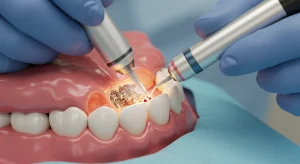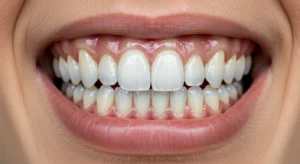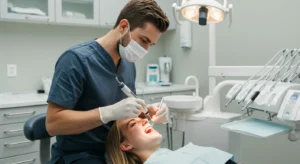
Discovering a cavity on the side of your tooth can be concerning. You might feel a rough spot with your tongue, experience sensitivity when eating, or notice a dark spot between your teeth. Side cavities, also called interproximal cavities, develop differently than cavities on the chewing surface and often go unnoticed until they cause problems.
Left untreated, a side cavity can grow, cause pain, and eventually require more extensive dental work than a simple filling.
This guide will explain everything you need to know about cavities on the side of teeth. You’ll learn why they form, how to recognize them, what treatment options are available, and how to prevent them.
What Is a Cavity on the Side of a Tooth?
A cavity on the side of a tooth is tooth decay that occurs on the surface where two teeth touch. Dentists call this area the interproximal surface. These cavities typically start small and develop slowly, often going undetected during regular brushing because you can’t see between your teeth easily.
Why Do Cavities Form on the Side of Teeth?
Poor Flossing Habits
The main reason people develop side cavities is inadequate flossing. Brushing alone removes only about 60% of plaque from your teeth. The remaining 40% sits between teeth and along the gum line.
Tight Contact Points
Some people naturally have teeth that sit very close together. These tight contact points make flossing difficult and uncomfortable, so people avoid it.
Frequent Snacking
Every time you eat, especially sugary or starchy foods, bacteria in your mouth produce acid. This acid attacks tooth enamel for about 20 minutes after eating.
Side cavities particularly develop when you eat sticky foods that lodge between teeth. Dried fruit, candy, chips, and bread all get stuck in these spaces and feed bacteria for hours.
Dry Mouth
Saliva naturally washes away food particles and neutralizes acids in your mouth. When you have dry mouth from medications, medical conditions, or dehydration, you lose this protective mechanism.
Sugary and Acidic Drinks
Sipping on soda, juice, sports drinks, or sweetened coffee throughout the day bathes your teeth in sugar and acid. The liquid flows between teeth, delivering decay-causing substances directly to the vulnerable side surfaces.
Previous Dental Work
Fillings, crowns, and other dental restorations can create small gaps or rough edges where food and bacteria collect. The margin between a filling and natural tooth is a common spot for new cavities to develop, especially on the sides of teeth.
Signs and Symptoms
Side cavities often develop without obvious symptoms in the early stages. As they progress, you might notice:
Sensitivity: Sharp pain when eating or drinking something cold, hot, sweet, or acidic. The sensation often comes and goes quickly but happens repeatedly in the same spot.
Food Trapping: Food consistently gets stuck between the same two teeth. You find yourself using toothpicks or floss to remove trapped food after every meal.
Rough Spot: Your tongue detects a rough or jagged edge when running over the side of a tooth. Healthy enamel feels smooth, while decay creates a textured surface.
Visible Dark Spot: When looking in a mirror with good lighting, you might see a brown or black spot between teeth. However, many side cavities remain invisible because they’re hidden in the contact area.
Pain When Chewing: Pressure on the tooth causes discomfort, especially when biting down on that side of your mouth.
Bad Breath: Bacteria trapped in a cavity produce foul-smelling compounds. If you have persistent bad breath that doesn’t improve with brushing, a hidden cavity might be the cause.
How Dentists Detect Side Cavities
Side cavities are tricky to find without professional examination. Dentists use several methods:
Visual Examination: During your checkup, the dentist looks between teeth with special mirrors and bright lights. They can spot color changes or obvious decay.
X-rays: Bitewing X-rays are essential for detecting side cavities. These X-rays show the areas between teeth where visual inspection can’t reach. They reveal cavities while they’re still small and treatable.
Explorer Tool: Dentists use a thin metal instrument with a pointed tip to gently probe tooth surfaces. Decayed areas feel soft or sticky compared to healthy enamel.
Laser Detection: Some dental offices use laser cavity detection systems that identify early decay before it’s visible on X-rays.
This is why regular dental checkups every six months are crucial. Many side cavities are caught before they cause symptoms, making treatment simpler and less expensive.
Treatment Options
Treatment depends on how advanced the cavity is.
Small Cavities: Fillings
Most side cavities are treated with dental fillings. The dentist removes the decayed portion of the tooth and fills the space with composite resin, amalgam, or other filling material.
The procedure typically requires local anesthesia to numb the area. The dentist accesses the cavity from the top or side of the tooth, removes all decay, and shapes the space to hold the filling. The entire process usually takes 30-60 minutes per tooth.
Moderate Cavities: Inlays or Onlays
When a cavity is too large for a simple filling but doesn’t require a full crown, dentists might recommend an inlay or onlay. These are custom-made restorations created in a dental lab that fit precisely into or onto your tooth.
The dentist prepares the tooth, takes impressions, and places a temporary restoration. You return in about two weeks for placement of the permanent restoration.
Large Cavities: Crowns
If decay has destroyed a significant portion of the tooth, a crown may be necessary. The dentist removes the decay, shapes the remaining tooth structure, and covers it with a cap that protects and strengthens the tooth.
Crowns require two visits. During the first visit, the tooth is prepared and a temporary crown is placed. The permanent crown is cemented during the second visit after the dental lab creates it.
Very Deep Cavities: Root Canals
When decay reaches the tooth’s pulp (the inner chamber containing nerves and blood vessels), a root canal becomes necessary. The dentist removes the infected pulp, cleans and disinfects the inside of the tooth, and seals it. A crown is typically placed over the tooth afterward.
Root canals have a bad reputation but are no more uncomfortable than getting a filling. The procedure saves the tooth and eliminates pain from infection.
Severe Cases: Extraction
If a tooth is too damaged to save, extraction may be the only option. This is rare for side cavities caught early but can happen if decay is ignored for years. After extraction, you’ll need a bridge, implant, or partial denture to replace the missing tooth.
Prevention Strategies
Preventing side cavities is straightforward but requires consistent daily habits.
Floss Every Day
This is the single most important thing you can do to prevent side cavities. Floss at least once daily, preferably before bed. Take your time and use proper technique. Curve the floss around each tooth in a C-shape and slide it up and down below the gum line.
If traditional floss is difficult, try floss picks, water flossers, or interdental brushes. The key is finding a method you’ll actually use every day.
Brush Properly
Brush twice daily for two minutes each time using fluoride toothpaste. Use gentle circular motions and angle the bristles toward the gum line.
Electric toothbrushes often clean more effectively than manual brushes. They have built-in timers to ensure you brush long enough.
Limit Sugary and Acidic Foods
Reduce how often you consume sugar and acidic foods. When you do eat them, have them with meals rather than as snacks. Your mouth produces more saliva during meals, which helps neutralize acids and wash away food particles.
Avoid sipping sugary or acidic drinks over long periods. If you drink soda or juice, use a straw to minimize contact with teeth, then rinse with water afterward.
Drink Water Throughout the Day
Water keeps your mouth clean and promotes saliva production. Drinking water after meals and snacks helps rinse away food particles and neutralize acids. Tap water in most areas contains fluoride, which strengthens tooth enamel.
Use Fluoride Products
Fluoride strengthens enamel and helps reverse early decay. Use fluoride toothpaste and consider a fluoride mouthwash if you’re prone to cavities.
Chew Sugar-Free Gum
Chewing sugar-free gum after meals stimulates saliva production and helps clean teeth. Look for gum containing xylitol, a natural sweetener that actually inhibits cavity-causing bacteria. Chew for 20 minutes after eating for maximum benefit.
Visit Your Dentist Regularly
Professional cleanings remove tartar that you can’t eliminate with brushing and flossing. Regular checkups allow your dentist to catch cavities early when treatment is simpler. Most people need cleanings every six months, but some require more frequent visits.
Consider Dental Sealants
While usually applied to back teeth, sealants can sometimes be used on vulnerable areas to prevent decay. Ask your dentist if this option makes sense for you.
Special Considerations
Children and Side Cavities
Children are especially likely to get side cavities because they often struggle with proper flossing technique. Parents should help young children floss until they develop the dexterity to do it effectively, usually around age 10-12.
Pediatric dentists can apply fluoride varnish and monitor cavity development closely. Teaching good habits early prevents dental problems later in life.
Pregnancy and Oral Health
Pregnant women are more prone to cavities due to hormonal changes, morning sickness, and dietary changes. The acid from vomiting erodes enamel, and cravings for sweets increase cavity risk.
Maintain excellent oral hygiene during pregnancy and see your dentist for regular cleanings. Dental work is safe during pregnancy, especially during the second trimester.
Braces and Orthodontic Appliances
Braces make flossing challenging but also make it more important. Food traps easily around brackets and wires, increasing cavity risk. Use floss threaders, orthodontic flossers, or water flossers to clean between teeth daily.
Book Your Appointment and Protect Your Smile
Don’t wait until a small issue becomes a big problem. Schedule your visit at Valencia Dental Center today and let our experienced team help you maintain your healthiest smile. We provide gentle, personalized care tailored to your needs. Your comfort and long-term dental health are always our top priority.
Conclusion
Cavities on the side of teeth are common but preventable. Daily flossing, proper brushing, a balanced diet, and regular dental visits can greatly reduce your risk of interproximal decay. Don’t ignore early signs like sensitivity or food getting stuck between teeth—these are warnings that need timely attention.
Everyone’s mouth is different, so it’s best to work with your dentist to create a prevention plan tailored to you. With consistent care and professional guidance, you can maintain strong, cavity-free teeth for life.
FAQs
Can a cavity on the side of a tooth heal on its own? Very early cavities may remineralize with good oral hygiene and fluoride, but once a hole forms, it cannot heal naturally. At that stage, only a dentist can remove the decay and restore the tooth.
How long does it take for a side cavity to form? The timeline depends on hygiene, diet, and individual risk factors. Some cavities can appear in just a few months, while others take years to develop. Side cavities often progress slower but are harder to notice early.
Are side cavities more serious than other cavities? They’re not inherently worse, but they’re harder to detect because they form between teeth. By the time you feel pain, they may already be advanced. Regular dental checkups help catch them before they become serious.
Why do I keep getting cavities between my teeth even though I brush? Brushing only cleans about 60% of your tooth surfaces, leaving the sides vulnerable. Without daily flossing, food and bacteria stay trapped and cause decay.
Does it hurt to get a side cavity filled? The procedure is painless because dentists use local anesthesia. You may feel mild pressure during the filling, but no sharp pain. Afterward, slight sensitivity is normal for a few days.
Can flossing prevent all side cavities? Flossing greatly reduces your risk, but it doesn’t guarantee complete protection. Factors like genetics, diet, and saliva also affect cavity risk. Still, daily flossing is the most effective step you can take.
What’s the best type of floss for preventing side cavities? The best floss is the one you’ll use consistently. Waxed floss works well for tight teeth, while tape floss covers more surface area. Water flossers are excellent for braces or dental work.
Can I see a side cavity in the mirror? Usually not until it’s advanced, since these cavities form where teeth touch. You might notice a dark spot on the edge, but many remain invisible. Dental X-rays are the most reliable way to detect them.





